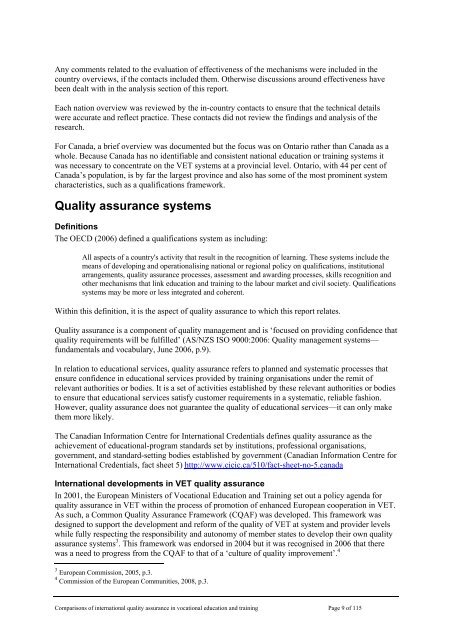Review - Department of Innovation, Industry, Science and Research
Review - Department of Innovation, Industry, Science and Research
Review - Department of Innovation, Industry, Science and Research
You also want an ePaper? Increase the reach of your titles
YUMPU automatically turns print PDFs into web optimized ePapers that Google loves.
Any comments related to the evaluation <strong>of</strong> effectiveness <strong>of</strong> the mechanisms were included in the<br />
country overviews, if the contacts included them. Otherwise discussions around effectiveness have<br />
been dealt with in the analysis section <strong>of</strong> this report.<br />
Each nation overview was reviewed by the in-country contacts to ensure that the technical details<br />
were accurate <strong>and</strong> reflect practice. These contacts did not review the findings <strong>and</strong> analysis <strong>of</strong> the<br />
research.<br />
For Canada, a brief overview was documented but the focus was on Ontario rather than Canada as a<br />
whole. Because Canada has no identifiable <strong>and</strong> consistent national education or training systems it<br />
was necessary to concentrate on the VET systems at a provincial level. Ontario, with 44 per cent <strong>of</strong><br />
Canada’s population, is by far the largest province <strong>and</strong> also has some <strong>of</strong> the most prominent system<br />
characteristics, such as a qualifications framework.<br />
Quality assurance systems<br />
Definitions<br />
The OECD (2006) defined a qualifications system as including:<br />
All aspects <strong>of</strong> a country's activity that result in the recognition <strong>of</strong> learning. These systems include the<br />
means <strong>of</strong> developing <strong>and</strong> operationalising national or regional policy on qualifications, institutional<br />
arrangements, quality assurance processes, assessment <strong>and</strong> awarding processes, skills recognition <strong>and</strong><br />
other mechanisms that link education <strong>and</strong> training to the labour market <strong>and</strong> civil society. Qualifications<br />
systems may be more or less integrated <strong>and</strong> coherent.<br />
Within this definition, it is the aspect <strong>of</strong> quality assurance to which this report relates.<br />
Quality assurance is a component <strong>of</strong> quality management <strong>and</strong> is ‘focused on providing confidence that<br />
quality requirements will be fulfilled’ (AS/NZS ISO 9000:2006: Quality management systems—<br />
fundamentals <strong>and</strong> vocabulary, June 2006, p.9).<br />
In relation to educational services, quality assurance refers to planned <strong>and</strong> systematic processes that<br />
ensure confidence in educational services provided by training organisations under the remit <strong>of</strong><br />
relevant authorities or bodies. It is a set <strong>of</strong> activities established by these relevant authorities or bodies<br />
to ensure that educational services satisfy customer requirements in a systematic, reliable fashion.<br />
However, quality assurance does not guarantee the quality <strong>of</strong> educational services—it can only make<br />
them more likely.<br />
The Canadian Information Centre for International Credentials defines quality assurance as the<br />
achievement <strong>of</strong> educational-program st<strong>and</strong>ards set by institutions, pr<strong>of</strong>essional organisations,<br />
government, <strong>and</strong> st<strong>and</strong>ard-setting bodies established by government (Canadian Information Centre for<br />
International Credentials, fact sheet 5) http://www.cicic.ca/510/fact-sheet-no-5.canada<br />
International developments in VET quality assurance<br />
In 2001, the European Ministers <strong>of</strong> Vocational Education <strong>and</strong> Training set out a policy agenda for<br />
quality assurance in VET within the process <strong>of</strong> promotion <strong>of</strong> enhanced European cooperation in VET.<br />
As such, a Common Quality Assurance Framework (CQAF) was developed. This framework was<br />
designed to support the development <strong>and</strong> reform <strong>of</strong> the quality <strong>of</strong> VET at system <strong>and</strong> provider levels<br />
while fully respecting the responsibility <strong>and</strong> autonomy <strong>of</strong> member states to develop their own quality<br />
assurance systems 3 . This framework was endorsed in 2004 but it was recognised in 2006 that there<br />
was a need to progress from the CQAF to that <strong>of</strong> a ‘culture <strong>of</strong> quality improvement’. 4<br />
3 European Commission, 2005, p.3.<br />
4 Commission <strong>of</strong> the European Communities, 2008, p.3.<br />
Comparisons <strong>of</strong> international quality assurance in vocational education <strong>and</strong> training Page 9 <strong>of</strong> 115
















